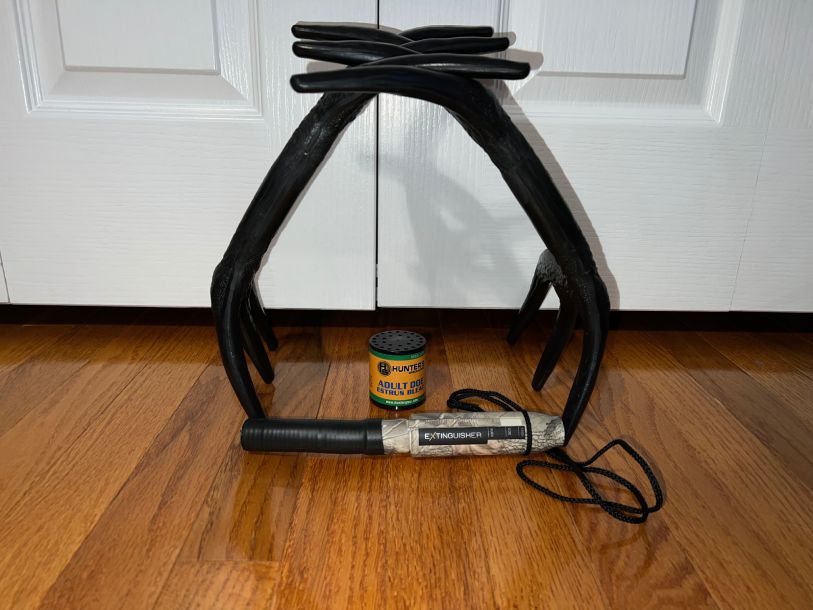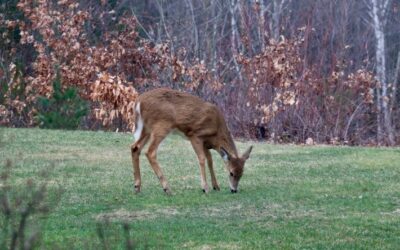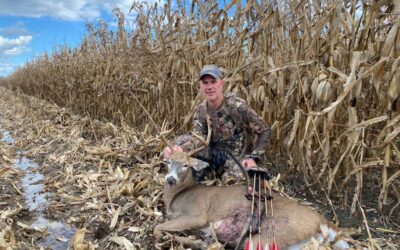This article may contain affiliate product links. I may receive a commission from sales. However, there is no extra cost to the buyer for using my affiliate link.
Using my affiliate links help support The Whitetail Teacher and allow me to deliver more content to help you become a better whitetail deer hunter.
Whitetail deer sounds have a wide variety of sounds that range in different tones and can have many different meanings. The way that whitetail deer use their various sounds can be a great resource for you to become a better hunter.
Each whitetail deer sound has a different meaning. Some of the sounds that whitetail deer make are still unknown to even biologists and expert deer hunters.
Nevertheless, the main deer vocalizations that you can use to your advantage are understood and will help you become a better deer hunter and deer caller.
Whitetail Buck Sounds
Whitetail bucks make a variety of sounds to indicate to other deer what is happening around them. Whitetail bucks are most vocal during the pre-rut and rut of the hunting season. More specifically, dominant bucks are the most vocal because they are territorial during the breeding season.
You will want to take into consideration how mature bucks interact with immature bucks and the different tones of each type of whitetail buck sounds.
- A big buck has more aggressive sounds to assert their dominance
- Young bucks will have less aggressive vocalizations
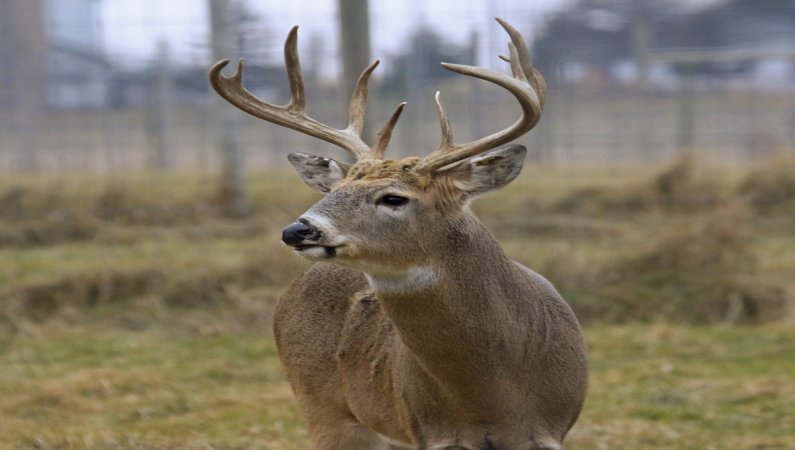
The 5 Main Buck Grunts and Sounds
1. Buck Grunt
The whitetail buck grunt is one of the most common sounds used by both whitetail bucks and deer hunters. A Buck grunt tends to be used by male whitetail deer to communicate their location with other whitetail deer.
Bucks will also use a short grunt to assert dominance over a smaller buck. This type of call is often referred to as one of the social calls or a contact call. Deer use social calls to establish their position and have general communication with other whitetail deer in the herd.
2. Buck Roar (also known as the Buck Bawl)
The buck roar is mostly reserved for mature bucks that have an estrus doe that they are looking to breed. A lot of times the mature buck that has been tending a doe overnight or for an extended period gets so frustrated because he wants to breed that he will use his most aggressive grunts (a buck roar) to express his frustration to that doe.
The buck roar is a guttural sound that comes from his gut. He is using that diaphragm to get more air to turn into a deeper tone. It is kind of like the difference between humans breathing with their stomachs and humans breathing with their heads.
It is the best time to use this deep buck roar after a sequence of tending grunts. Mature bucks will be extremely upset if they feel that another adult deer is in the area and has a doe in estrus to breed.
3. The Tending Grunt
The tending grunt is a type of buck grunt that is used when a whitetail buck is chasing a doe. They will often make a series of short grunts. These short grunts can sometimes align with the actual steps of the deer.
I would advise you to not become like a robot and do a sequence of buck grunts that have the same time interval between each one.
- Don’t Do When Making a Tending Grunt Deer Sounds: TIK, TIK, TIK, TIK, TIK
- What To Do When Making a Tending Grunt Deer Sound: TIK, tikkkKK, TIKKKkk, TikkkK, tikkk
It is good to mix up the tones of each tending grunt because that is how deer will also tend a doe. They will vary the deer sounds that they make. Every deer has a wide range of sounds that they will use. I am not sure why bucks do this, but they like to vary their sounds.
The tending grunt or trailing grunt is one of my favorite calls for the pre-rut because it will entice other bucks in the area to feel as if they have missed out on a doe in heat. Whitetail bucks spend all year getting ready for the rutting season and a mature male buck will not let young deer breed more than him.
The mature bucks will not let some other buck just start breeding in his area where he has established himself as the dominant buck. This will get him up and moving toward the call to check out what is going on. That is when he will come and give you a great shot.
4. Snort Wheeze
The snort wheeze is one of the most aggressive calls to use when you see a mature buck trotting through the woods and you want to challenge him which will, in turn, bring him in for a shot. This snort wheeze is like the biggest middle finger to a dominant buck that has established your hunting property as his home range.
Let us play it out as if you were sitting in the tree stand. You see a shooter buck at about 100 – 200 yards away. You want to hit him with a contact grunt to get him to look your way. Occasionally that is all you will need to get that mature buck’s attention and have him start coming your way.
However, if he starts to continue his previous path searching for a hot doe to breed, you can use a snort-wheeze deer sound to let him know that another buck is challenging his dominance in this area. Then he will be faced with a choice. He either has to deny the challenge or go and check out what buck is trying to challenge him and his dominance in the area.
To do a proper snort wheeze, you will want to do two or three short breaths through a snort wheeze call and then immediately follow it with one longer blow through the call.
You can do this using just your mouth by doing two to three short shooshing sounds followed by one longer shooshing sound.
5. Rattling Sound
A rattling sound is when you create the illusion that two bucks have come into an encounter and are fighting to test the dominance hierarchy of the deer herd. There is also occasionally a “prize” for the winner of the fight. That being a doe that is coming into heat and ready to breed.
There are many ways that you can rattle in bucks. How to rattle in bigger bucks depends on how you want to approach rattling. I like doing a mix of both blind calling and rattling and trying to get the attention of a buck I see in the distance.
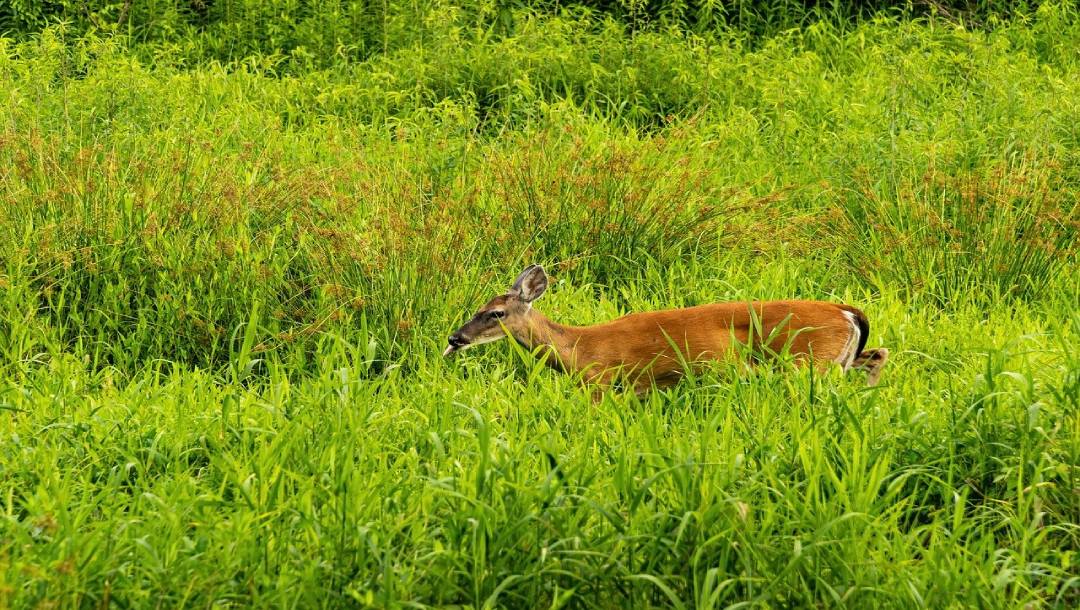
Whitetail Doe Sounds
Whitetail doe tends to use fewer vocalizations than whitetail bucks. Their deer sounds are often in a higher pitch than bucks. The deer sounds that do make tend to be related to their safety, their fawns, and the rut to breed.
Doe Grunt
A doe grunt is like a buck grunt they will use this to let other deer know that they are in the area. They also will do a grunt or two to help their fawns locate them and make sure that they stay close to them. Female whitetail deer have strong maternal instincts for their offspring, and they want to ensure that their fawns stay close which means stay safe. Mother deer are great protectors of their fawns and the entire deer herd.
This type of grunt is another deer sound that is seen as a social grunt. It does not mean much more than establishing the location of the deer making the sound.
Estrus Bleat
An estrus bleat is a type of call that a doe uses to let a buck know that she is ready to breed. It is best to use a doe bleat at the peak of the rut. You want to use this during the peak of the rut because of the probability that a doe would be in estrus.
Most of the doe in estrus calls are made in a can. I find that these types of calls are the best for storage and ease of use.
Whitetail Fawn Sounds
A fawn has the highest-pitched deer sound out of every other deer sound in the woods. It is uncommon for a whitetail hunter to use a baby deer noise to attract other deer.
The main reason that a fawn would be making any type of sound is to let its mother know where it is. The other reason would be that they are in distress.
A fawn in distress call, in my opinion, is meant for coyote hunting more than anything.
I do not mess with the fawn call while I am whitetail deer hunting, but if you want to give it a try, let me know how it goes.
Deer Sounds Both Males and Females Use
Blowing or Deer Snort
As a hunter, you hate to hear a blowing deer sound. It often comes from a doe, but it can also be done by a buck. Either way most times it is not a good sign when a deer makes a blowing sound followed by an entire food plot full of deer running back into the woods.
However, a blowing sound does not mean that a deer has winded you. It could just mean that the deer is alarmed or does not feel everything is normal. It could be a coyote, a fox, or anything else that may cause a deer to become uncomfortable in its current surroundings.
Do not be mistaken, if a deer looks right at you and then blows, that deer busted you. It is not the end of your hunt if a deer has busted you with an alarm snort. It happens and although it is not ideal, it is not the end of the world. If you want to know what a blowing sound sounds like, go out and hunt. It is kind of like a hunting right of passage as a hunter. Or you can just go look on YouTube…
All the deer blowing is meant to do is get the attention of other deer to let them know something is wrong with this specific situation or area. It is another form of social communication for the deer herd. It is also one of the most common vocalizations when you are a beginner hunter.
The actual act of blowing for a deer is to clear out their nostrils so they can get a better scent through their great nose. You may also see the deer lick their noses. This also helps them get a better scent as well.
Stomping
While stomping is not necessarily a sound that comes from a deer’s lungs, it is a way that they communicate with each other. A deer stomping is normally a pre-signal to the blowing sound. Stomping for a deer is another way that a deer will alert the rest of the herd that something is bothering them. Once again, most times a doe with stomp and blow. A buck will more than likely just sneak off to ensure their safety.
Contact Grunts
When I mentioned the grunts that bucks and does make, I wanted to mention that each of those grunts can be used as contact grunts or social grunts. These social grunts and contact grunts are just a way for deer to communicate socially. Unlike humans, deer have a basic form of communication, and they also want to let the other deer in the herd that they are there.
So if you hear a singular grunt from a buck or doe, it may just be a contact grunt and have nothing to do with breeding.
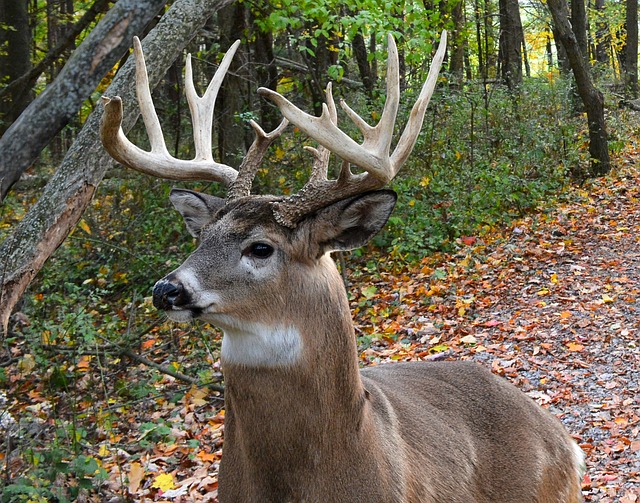
The Difference in Pitches and Volume
In the area where I normally hunt in Michigan, the mature bucks are few and far between. This means that I must be careful with the aggressive calls that I use. If you use a dominant buck call when there are few mature bucks, you can scare the younger bucks away.
Make sure that you know what kind of deer herd you have before you go making too many deer sounds in the woods.
A younger buck will have a higher-pitched grunt. This can be a benefit to you and your calling sequences because a younger buck call tending a doe may upset a more dominant buck. Just be careful and experiment with the different calling sequences based on your knowledge of the deer herd in your area.
3 Most Essential Calls to Have in Your Backpack
1. A Grunt Call
A good grunt call can be a great product to use to manipulate bucks into coming into shooting range. The best deer sound will come from the best grunt call.
I like to use the Extinguisher Grunt Call by The Deer Society. This grunt tube has three different sounds that it can create. The first deer sound is a buck grunt. The second deer sound is a doe grunt. The third deer sound is a fawn bleat.
2. A Doe in Estrus Bleat
A doe in estrus bleat is a good way to entice bucks into your hunting spot. It is best to use this sound at the peak of the rut when there is a good possibility that a doe is in heat.
I use the Adult Doe in Estrus Bleat Can. I do not use this call very often due to the specific timing that is necessary for it to be effective.
3. Rattling Antlers
When it comes to rattling antlers, there are two different types of products that will work great. The first option is a rattle bag. I used a rattle bag till last year. I liked the ease of use and portability. However, the rattling sounds that it makes are not always the most realistic.
The second option is a set of fake rattling antlers that you can control a bit better. I like to use the Black Rack by The Deer Society as well. They offer a sleek design and a realistic deer sound.
Conclusion
Whitetail deer sounds are rarer than they may seem to be. It is a cool and great experience if you hear deer making their natural sounds in the woods. However, a hunter needs to be able to communicate with the deer. If you can accurately communicate with the proper deer sound, you may be able to shoot the buck of a lifetime.
I would suggest that you practice in the offseason with your deer calls and not be afraid to fail while you are hunting in the woods. You will be able to learn a ton of information if you even just attempt to communicate with the deer using deer sounds.
Check out this video to learn more about rattling.
Check out this video to learn more about grunt calls and how to use them.
This article should be able to answer many of your questions that you may have had about what sound a whitetail deer makes. Each deer is unique in their deer sounds so try to be unique with any of your calling sequences.
Thank you for visiting The Whitetail Teacher! If you enjoyed this post, make sure to share it with a friend.
If you have any questions or recommendations for new blog posts, please use the contact form.
Learn, Plan, Execute,
The Whitetail Teacher

